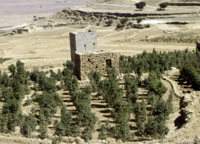
The village that turned into qat fields [Archives:2007/1113/Last Page]
December 20 2007
 |
For the Yemen Times
Qaren, a mountainous area in Amran, has experienced qat cultivation since 2004. Now the process has increased remarkably. Despite the mountainous nature and terraces of the area, qat crops reached 2,176,000 square meters in 2007. Springs and streams do not exist in the area, which depends mainly on the rainy season for water. Therefore, locals were obliged to drill wells randomly to meet qat's water demand.
Individual efforts are being exerted to educate the public about the risks and dire consequences caused by qat cultivation. Rashad Al-Qareni, a local, said that locals committed a mistake by planting qat trees in the entire area, which demand huge quantities of water, while they live in a twenty-house village suffering from a lack of water. According to Rashad, it has forced locals to resort to big water trucks to transport water from the water supply system. Water brought from others areas did not go to all lands cultivated with qat, making locals drill four wells, of which two dried up.
Rashad used the leverage of some locals to stand against further water depletion. His attempt was futile, as concerned parties remain deaf toward the issue.
Qaren is famous for the good quality of its qat. Recent price hikes in qat resulted in Rashad? cultivating 4,400 square meters over the last three months, reaching 7,480 square meters of his land, 11,000 square meters in area.
Local used to cultivate their lands with cereals such as corn, barley, wheat, and other crops. Now it has been changed into qat saplings grown in the area.
However, Ali Al-Qaren, one of the locals, argued that qat cultivation is more profitable than cereals cultivation. Qaren qat branches are the best in quality; therefore, qat is more expensive there, compared to other areas. For that matter, Ali Al-Qaren resorted to planting qat on 5,720 square meters of his own land. Cereal crops are harvested only once a year, whereas qat can be harvested more than twice annually.
Despite warnings against qat cultivation made by certain parties, the process of planting qat trees is increasingly growing.
Abdu M. Humran, Dean of Education of Faculty in Amran, considered the situation very dangerous, in addition to the impact he claims is inflicted upon Yemeni families by buying qat at exhorbitant prices and its negative impact on agriculture.
\”Qat depletes a huge quantity of ground water. It also consumes a lot of pesticides


